In-depth Clinical Update: Alzheimer's Disease - Semester 1 2019
VerifiedAdded on 2023/04/24
|13
|3277
|403
Report
AI Summary
This clinical update provides a comprehensive overview of Alzheimer's disease, a progressive neurological disorder affecting brain function. It covers key aspects such as risk factors (age, genetics, environment), clinical manifestations (mild, moderate, severe), diagnostic procedures (physical exams, neurological exams, MRI, CT scan) and treatment options (pharmacological and non-pharmacological). The report details the pathophysiology of Alzheimer's, including the role of amyloid plaques and neurofibrillary tangles, and discusses various management strategies aimed at maintaining patient efficiency and quality of life. This resource is valuable for understanding the complexities of Alzheimer's disease and its clinical management.
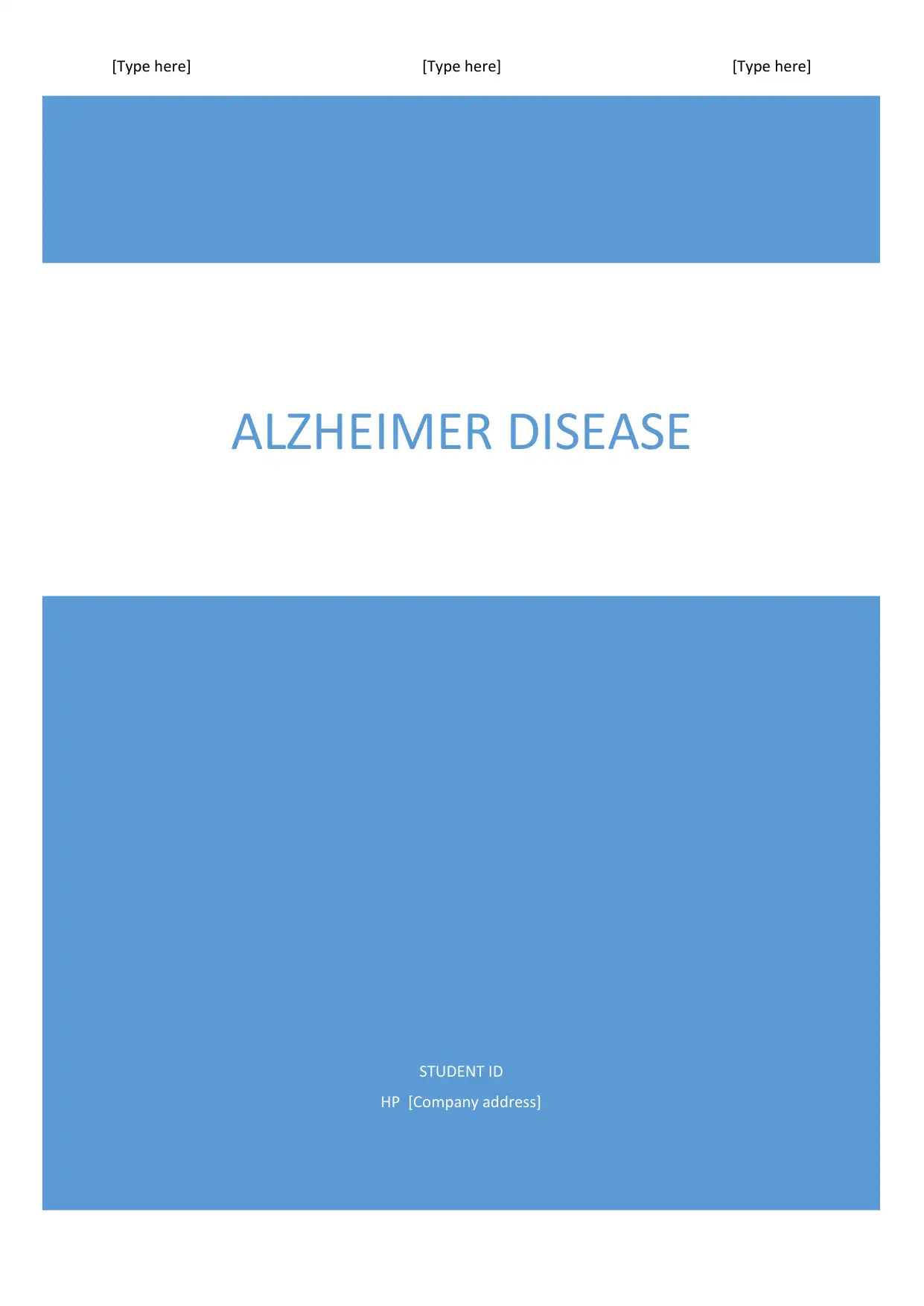
STUDENT ID
HP [Company address]
ALZHEIMER DISEASE
[Type here] [Type here] [Type here]
HP [Company address]
ALZHEIMER DISEASE
[Type here] [Type here] [Type here]
Paraphrase This Document
Need a fresh take? Get an instant paraphrase of this document with our AI Paraphraser
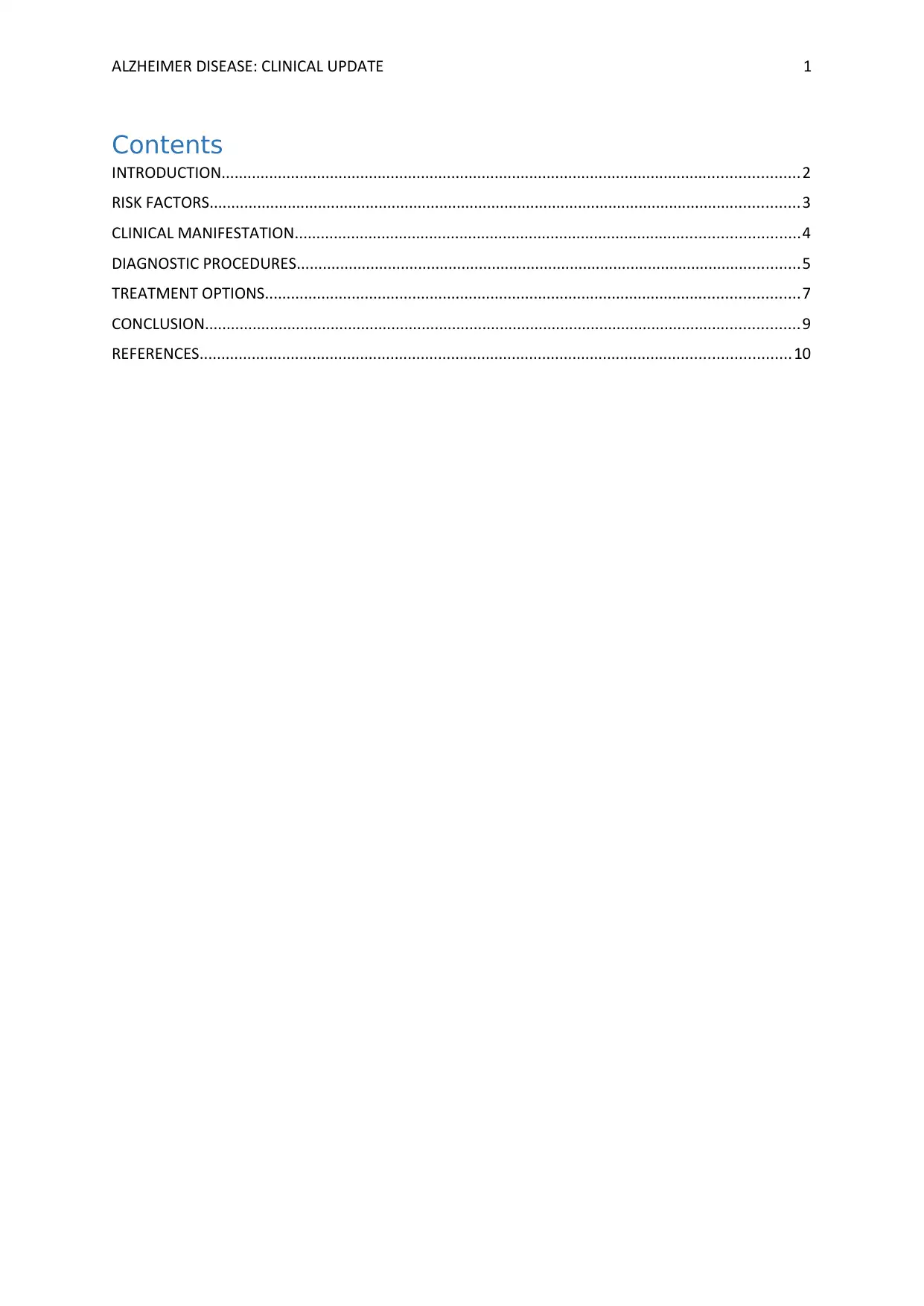
ALZHEIMER DISEASE: CLINICAL UPDATE 1
Contents
INTRODUCTION.....................................................................................................................................2
RISK FACTORS........................................................................................................................................3
CLINICAL MANIFESTATION....................................................................................................................4
DIAGNOSTIC PROCEDURES....................................................................................................................5
TREATMENT OPTIONS...........................................................................................................................7
CONCLUSION.........................................................................................................................................9
REFERENCES........................................................................................................................................10
Contents
INTRODUCTION.....................................................................................................................................2
RISK FACTORS........................................................................................................................................3
CLINICAL MANIFESTATION....................................................................................................................4
DIAGNOSTIC PROCEDURES....................................................................................................................5
TREATMENT OPTIONS...........................................................................................................................7
CONCLUSION.........................................................................................................................................9
REFERENCES........................................................................................................................................10
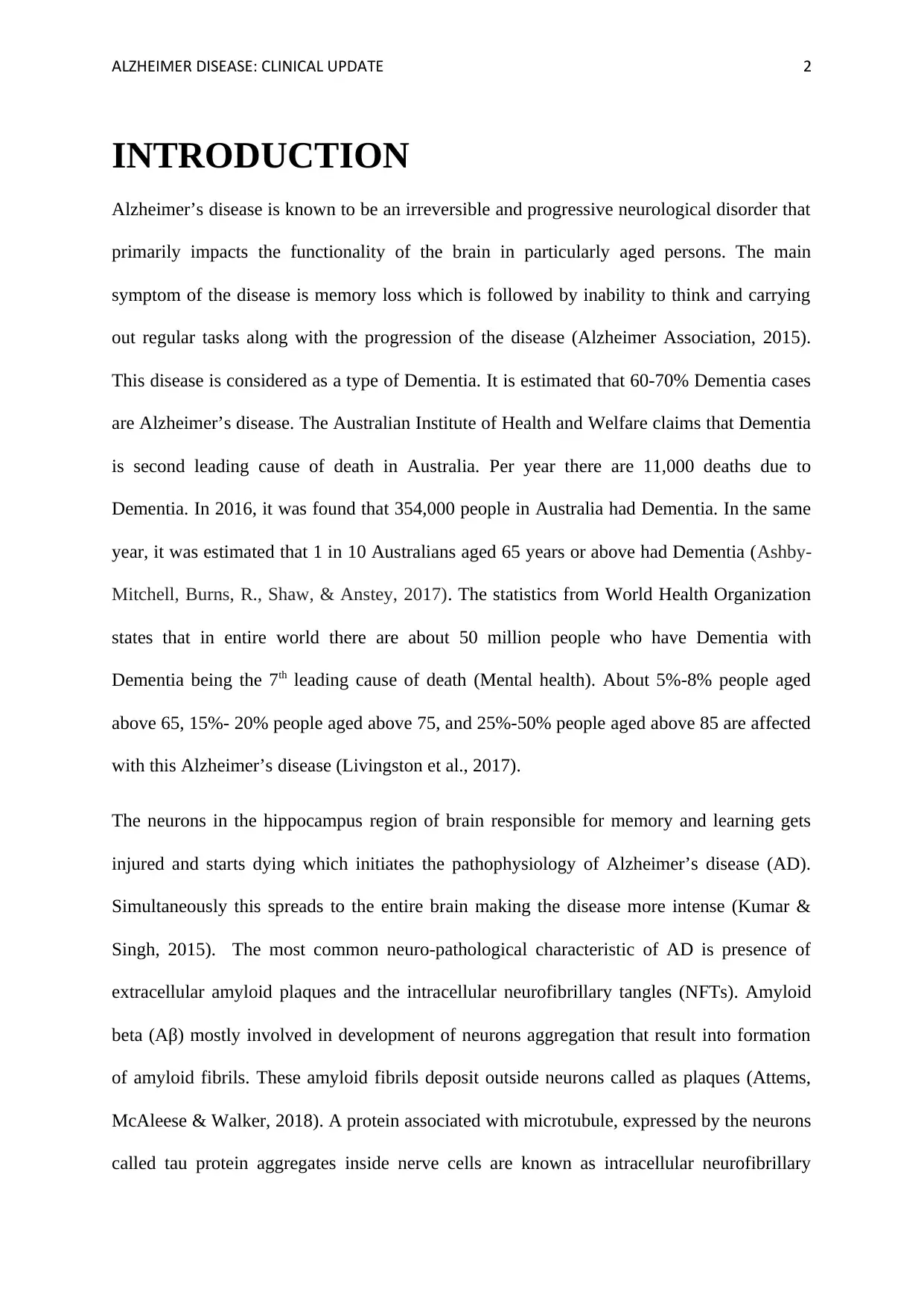
ALZHEIMER DISEASE: CLINICAL UPDATE 2
INTRODUCTION
Alzheimer’s disease is known to be an irreversible and progressive neurological disorder that
primarily impacts the functionality of the brain in particularly aged persons. The main
symptom of the disease is memory loss which is followed by inability to think and carrying
out regular tasks along with the progression of the disease (Alzheimer Association, 2015).
This disease is considered as a type of Dementia. It is estimated that 60-70% Dementia cases
are Alzheimer’s disease. The Australian Institute of Health and Welfare claims that Dementia
is second leading cause of death in Australia. Per year there are 11,000 deaths due to
Dementia. In 2016, it was found that 354,000 people in Australia had Dementia. In the same
year, it was estimated that 1 in 10 Australians aged 65 years or above had Dementia (Ashby-
Mitchell, Burns, R., Shaw, & Anstey, 2017). The statistics from World Health Organization
states that in entire world there are about 50 million people who have Dementia with
Dementia being the 7th leading cause of death (Mental health). About 5%-8% people aged
above 65, 15%- 20% people aged above 75, and 25%-50% people aged above 85 are affected
with this Alzheimer’s disease (Livingston et al., 2017).
The neurons in the hippocampus region of brain responsible for memory and learning gets
injured and starts dying which initiates the pathophysiology of Alzheimer’s disease (AD).
Simultaneously this spreads to the entire brain making the disease more intense (Kumar &
Singh, 2015). The most common neuro-pathological characteristic of AD is presence of
extracellular amyloid plaques and the intracellular neurofibrillary tangles (NFTs). Amyloid
beta (Aβ) mostly involved in development of neurons aggregation that result into formation
of amyloid fibrils. These amyloid fibrils deposit outside neurons called as plaques (Attems,
McAleese & Walker, 2018). A protein associated with microtubule, expressed by the neurons
called tau protein aggregates inside nerve cells are known as intracellular neurofibrillary
INTRODUCTION
Alzheimer’s disease is known to be an irreversible and progressive neurological disorder that
primarily impacts the functionality of the brain in particularly aged persons. The main
symptom of the disease is memory loss which is followed by inability to think and carrying
out regular tasks along with the progression of the disease (Alzheimer Association, 2015).
This disease is considered as a type of Dementia. It is estimated that 60-70% Dementia cases
are Alzheimer’s disease. The Australian Institute of Health and Welfare claims that Dementia
is second leading cause of death in Australia. Per year there are 11,000 deaths due to
Dementia. In 2016, it was found that 354,000 people in Australia had Dementia. In the same
year, it was estimated that 1 in 10 Australians aged 65 years or above had Dementia (Ashby-
Mitchell, Burns, R., Shaw, & Anstey, 2017). The statistics from World Health Organization
states that in entire world there are about 50 million people who have Dementia with
Dementia being the 7th leading cause of death (Mental health). About 5%-8% people aged
above 65, 15%- 20% people aged above 75, and 25%-50% people aged above 85 are affected
with this Alzheimer’s disease (Livingston et al., 2017).
The neurons in the hippocampus region of brain responsible for memory and learning gets
injured and starts dying which initiates the pathophysiology of Alzheimer’s disease (AD).
Simultaneously this spreads to the entire brain making the disease more intense (Kumar &
Singh, 2015). The most common neuro-pathological characteristic of AD is presence of
extracellular amyloid plaques and the intracellular neurofibrillary tangles (NFTs). Amyloid
beta (Aβ) mostly involved in development of neurons aggregation that result into formation
of amyloid fibrils. These amyloid fibrils deposit outside neurons called as plaques (Attems,
McAleese & Walker, 2018). A protein associated with microtubule, expressed by the neurons
called tau protein aggregates inside nerve cells are known as intracellular neurofibrillary
⊘ This is a preview!⊘
Do you want full access?
Subscribe today to unlock all pages.

Trusted by 1+ million students worldwide
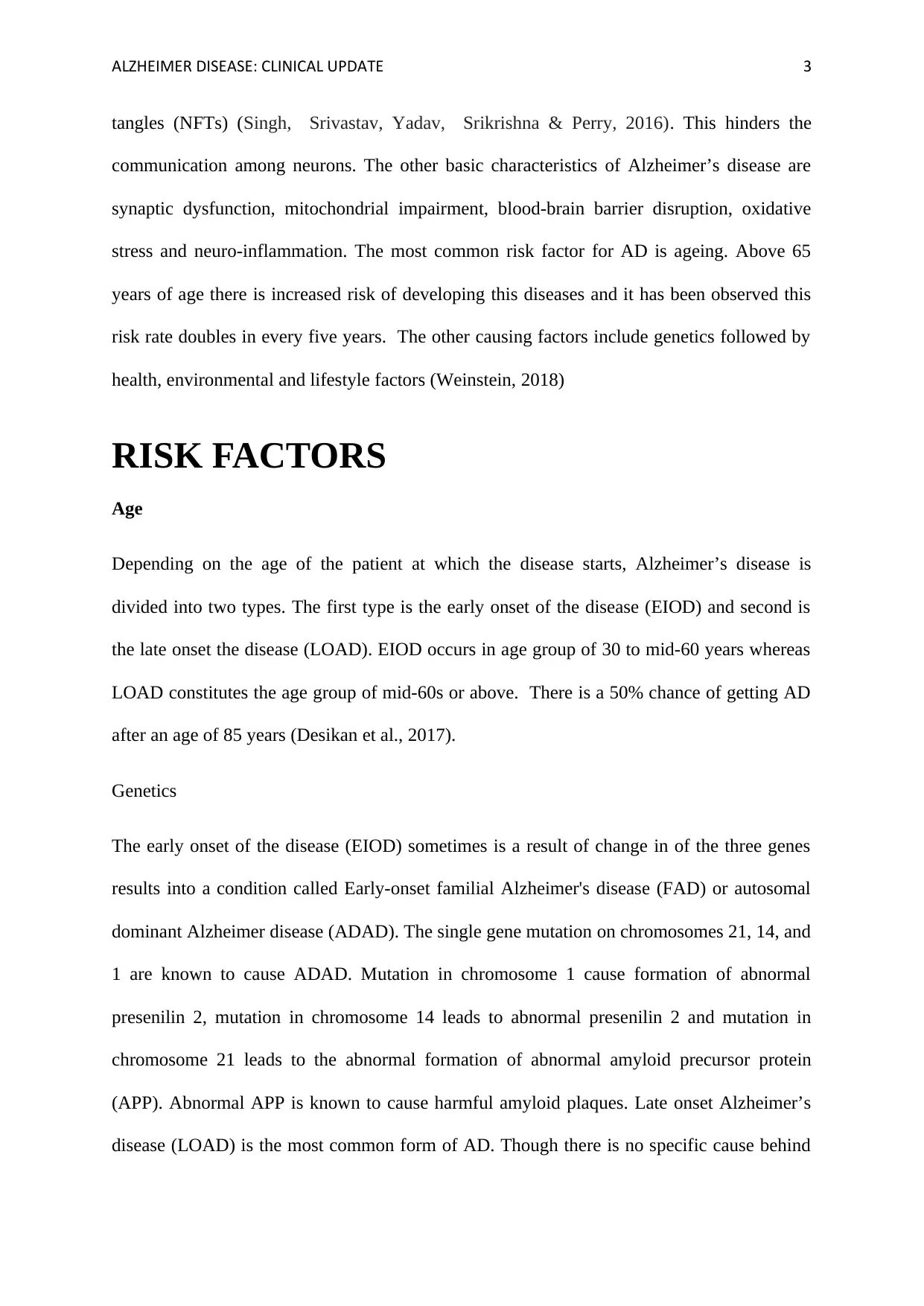
ALZHEIMER DISEASE: CLINICAL UPDATE 3
tangles (NFTs) (Singh, Srivastav, Yadav, Srikrishna & Perry, 2016). This hinders the
communication among neurons. The other basic characteristics of Alzheimer’s disease are
synaptic dysfunction, mitochondrial impairment, blood-brain barrier disruption, oxidative
stress and neuro-inflammation. The most common risk factor for AD is ageing. Above 65
years of age there is increased risk of developing this diseases and it has been observed this
risk rate doubles in every five years. The other causing factors include genetics followed by
health, environmental and lifestyle factors (Weinstein, 2018)
RISK FACTORS
Age
Depending on the age of the patient at which the disease starts, Alzheimer’s disease is
divided into two types. The first type is the early onset of the disease (EIOD) and second is
the late onset the disease (LOAD). EIOD occurs in age group of 30 to mid-60 years whereas
LOAD constitutes the age group of mid-60s or above. There is a 50% chance of getting AD
after an age of 85 years (Desikan et al., 2017).
Genetics
The early onset of the disease (EIOD) sometimes is a result of change in of the three genes
results into a condition called Early-onset familial Alzheimer's disease (FAD) or autosomal
dominant Alzheimer disease (ADAD). The single gene mutation on chromosomes 21, 14, and
1 are known to cause ADAD. Mutation in chromosome 1 cause formation of abnormal
presenilin 2, mutation in chromosome 14 leads to abnormal presenilin 2 and mutation in
chromosome 21 leads to the abnormal formation of abnormal amyloid precursor protein
(APP). Abnormal APP is known to cause harmful amyloid plaques. Late onset Alzheimer’s
disease (LOAD) is the most common form of AD. Though there is no specific cause behind
tangles (NFTs) (Singh, Srivastav, Yadav, Srikrishna & Perry, 2016). This hinders the
communication among neurons. The other basic characteristics of Alzheimer’s disease are
synaptic dysfunction, mitochondrial impairment, blood-brain barrier disruption, oxidative
stress and neuro-inflammation. The most common risk factor for AD is ageing. Above 65
years of age there is increased risk of developing this diseases and it has been observed this
risk rate doubles in every five years. The other causing factors include genetics followed by
health, environmental and lifestyle factors (Weinstein, 2018)
RISK FACTORS
Age
Depending on the age of the patient at which the disease starts, Alzheimer’s disease is
divided into two types. The first type is the early onset of the disease (EIOD) and second is
the late onset the disease (LOAD). EIOD occurs in age group of 30 to mid-60 years whereas
LOAD constitutes the age group of mid-60s or above. There is a 50% chance of getting AD
after an age of 85 years (Desikan et al., 2017).
Genetics
The early onset of the disease (EIOD) sometimes is a result of change in of the three genes
results into a condition called Early-onset familial Alzheimer's disease (FAD) or autosomal
dominant Alzheimer disease (ADAD). The single gene mutation on chromosomes 21, 14, and
1 are known to cause ADAD. Mutation in chromosome 1 cause formation of abnormal
presenilin 2, mutation in chromosome 14 leads to abnormal presenilin 2 and mutation in
chromosome 21 leads to the abnormal formation of abnormal amyloid precursor protein
(APP). Abnormal APP is known to cause harmful amyloid plaques. Late onset Alzheimer’s
disease (LOAD) is the most common form of AD. Though there is no specific cause behind
Paraphrase This Document
Need a fresh take? Get an instant paraphrase of this document with our AI Paraphraser
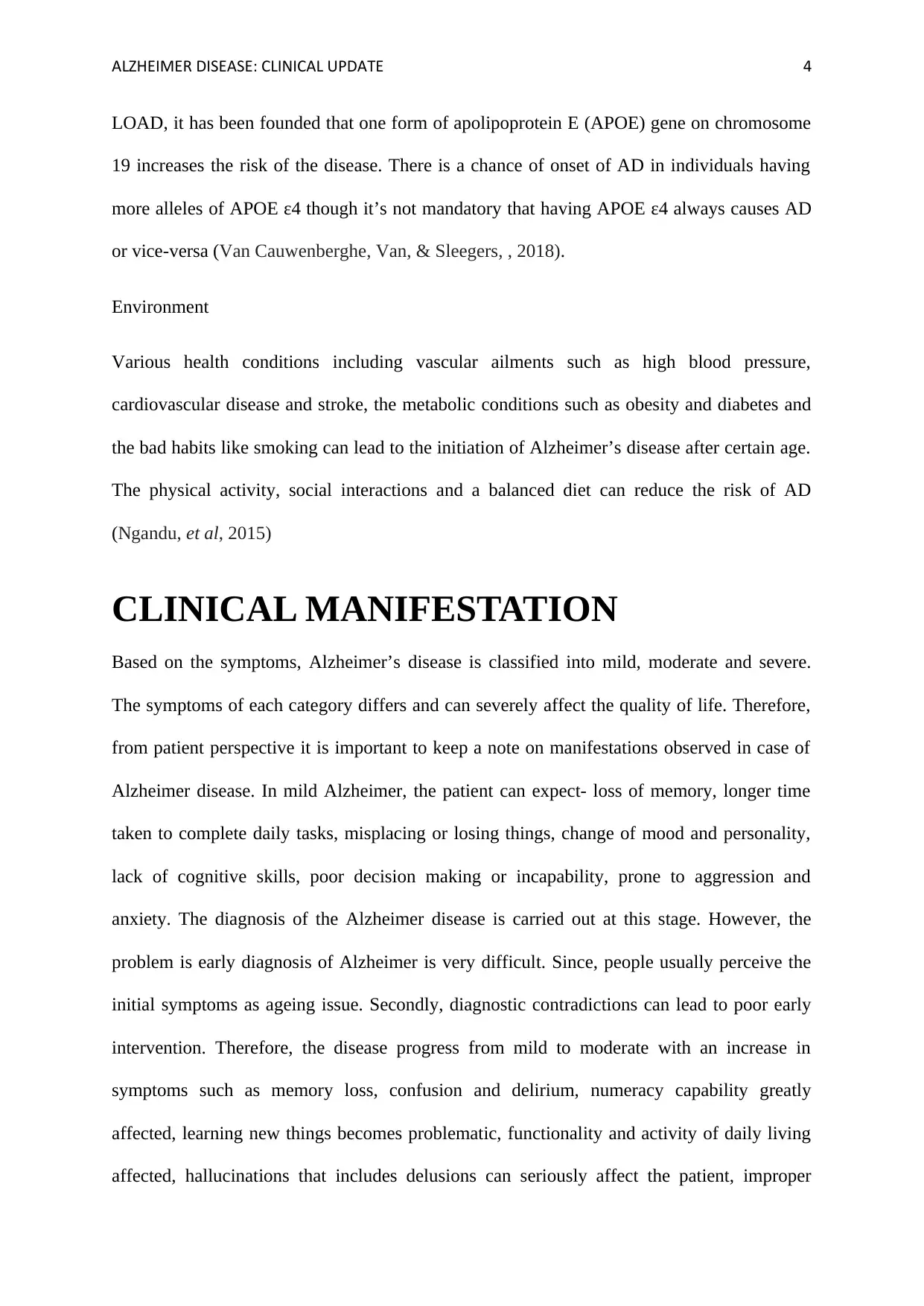
ALZHEIMER DISEASE: CLINICAL UPDATE 4
LOAD, it has been founded that one form of apolipoprotein E (APOE) gene on chromosome
19 increases the risk of the disease. There is a chance of onset of AD in individuals having
more alleles of APOE ɛ4 though it’s not mandatory that having APOE ɛ4 always causes AD
or vice-versa (Van Cauwenberghe, Van, & Sleegers, , 2018).
Environment
Various health conditions including vascular ailments such as high blood pressure,
cardiovascular disease and stroke, the metabolic conditions such as obesity and diabetes and
the bad habits like smoking can lead to the initiation of Alzheimer’s disease after certain age.
The physical activity, social interactions and a balanced diet can reduce the risk of AD
(Ngandu, et al, 2015)
CLINICAL MANIFESTATION
Based on the symptoms, Alzheimer’s disease is classified into mild, moderate and severe.
The symptoms of each category differs and can severely affect the quality of life. Therefore,
from patient perspective it is important to keep a note on manifestations observed in case of
Alzheimer disease. In mild Alzheimer, the patient can expect- loss of memory, longer time
taken to complete daily tasks, misplacing or losing things, change of mood and personality,
lack of cognitive skills, poor decision making or incapability, prone to aggression and
anxiety. The diagnosis of the Alzheimer disease is carried out at this stage. However, the
problem is early diagnosis of Alzheimer is very difficult. Since, people usually perceive the
initial symptoms as ageing issue. Secondly, diagnostic contradictions can lead to poor early
intervention. Therefore, the disease progress from mild to moderate with an increase in
symptoms such as memory loss, confusion and delirium, numeracy capability greatly
affected, learning new things becomes problematic, functionality and activity of daily living
affected, hallucinations that includes delusions can seriously affect the patient, improper
LOAD, it has been founded that one form of apolipoprotein E (APOE) gene on chromosome
19 increases the risk of the disease. There is a chance of onset of AD in individuals having
more alleles of APOE ɛ4 though it’s not mandatory that having APOE ɛ4 always causes AD
or vice-versa (Van Cauwenberghe, Van, & Sleegers, , 2018).
Environment
Various health conditions including vascular ailments such as high blood pressure,
cardiovascular disease and stroke, the metabolic conditions such as obesity and diabetes and
the bad habits like smoking can lead to the initiation of Alzheimer’s disease after certain age.
The physical activity, social interactions and a balanced diet can reduce the risk of AD
(Ngandu, et al, 2015)
CLINICAL MANIFESTATION
Based on the symptoms, Alzheimer’s disease is classified into mild, moderate and severe.
The symptoms of each category differs and can severely affect the quality of life. Therefore,
from patient perspective it is important to keep a note on manifestations observed in case of
Alzheimer disease. In mild Alzheimer, the patient can expect- loss of memory, longer time
taken to complete daily tasks, misplacing or losing things, change of mood and personality,
lack of cognitive skills, poor decision making or incapability, prone to aggression and
anxiety. The diagnosis of the Alzheimer disease is carried out at this stage. However, the
problem is early diagnosis of Alzheimer is very difficult. Since, people usually perceive the
initial symptoms as ageing issue. Secondly, diagnostic contradictions can lead to poor early
intervention. Therefore, the disease progress from mild to moderate with an increase in
symptoms such as memory loss, confusion and delirium, numeracy capability greatly
affected, learning new things becomes problematic, functionality and activity of daily living
affected, hallucinations that includes delusions can seriously affect the patient, improper

ALZHEIMER DISEASE: CLINICAL UPDATE 5
speech, poor coping skills. In case of severe Alzheimer disease, communication capability
significantly reduces, significant weight loss occurs as patient forgets how to eat and
swallow, poor bladder control, seizures and skin infections due to poor hygiene (Bird, 2015).
Due to such severity in the symptoms, the patient get dependent on others and the cost of
dementia or Alzheimer care increases significantly.
DIAGNOSTIC PROCEDURES
Doctors conduct physical and neurological exams with standard mental functional test to
check signs of intellectual impairment for diagnosis of the Alzheimer’s disease. In 2011, new
criteria have been set to diagnose AD.
Amnestic presentation: this kind of presentation occurs very often for dementia in
Alzheimer’s disease. This includes the learning impairment and patient’s inability to recall
from what he or she has learnt. Non-amnestic presentations or the Language presentation:
This includes language and visuospatial presentation. The deficit in language presentation
includes difficulty in finding words. The bisuospatial presentation includes impaired face
recognition, object agnosia, alexia and simultanagnosia (Mez, 2013).
Executive dysfunction The major dysfunctions included are impaired reasoning,
judgment, and problem solving. This demands the presence of other cognitive domains. In
order to exclude other medical factors contributing to reduced brain functioning, MRI, CT
scan and other laboratory testing are done. Since the changes occurred in brain tissue of AD
patients are extremely small, so the changes can be seen only after doing autopsy (Johnson,
Fox, Sperling & Klunk, 2012). It is very important to rule out other forms of dementia,
before starting the treatment for Alzheimer’s disease. The following points are considered to
rule out other forms of dementia.
speech, poor coping skills. In case of severe Alzheimer disease, communication capability
significantly reduces, significant weight loss occurs as patient forgets how to eat and
swallow, poor bladder control, seizures and skin infections due to poor hygiene (Bird, 2015).
Due to such severity in the symptoms, the patient get dependent on others and the cost of
dementia or Alzheimer care increases significantly.
DIAGNOSTIC PROCEDURES
Doctors conduct physical and neurological exams with standard mental functional test to
check signs of intellectual impairment for diagnosis of the Alzheimer’s disease. In 2011, new
criteria have been set to diagnose AD.
Amnestic presentation: this kind of presentation occurs very often for dementia in
Alzheimer’s disease. This includes the learning impairment and patient’s inability to recall
from what he or she has learnt. Non-amnestic presentations or the Language presentation:
This includes language and visuospatial presentation. The deficit in language presentation
includes difficulty in finding words. The bisuospatial presentation includes impaired face
recognition, object agnosia, alexia and simultanagnosia (Mez, 2013).
Executive dysfunction The major dysfunctions included are impaired reasoning,
judgment, and problem solving. This demands the presence of other cognitive domains. In
order to exclude other medical factors contributing to reduced brain functioning, MRI, CT
scan and other laboratory testing are done. Since the changes occurred in brain tissue of AD
patients are extremely small, so the changes can be seen only after doing autopsy (Johnson,
Fox, Sperling & Klunk, 2012). It is very important to rule out other forms of dementia,
before starting the treatment for Alzheimer’s disease. The following points are considered to
rule out other forms of dementia.
⊘ This is a preview!⊘
Do you want full access?
Subscribe today to unlock all pages.

Trusted by 1+ million students worldwide
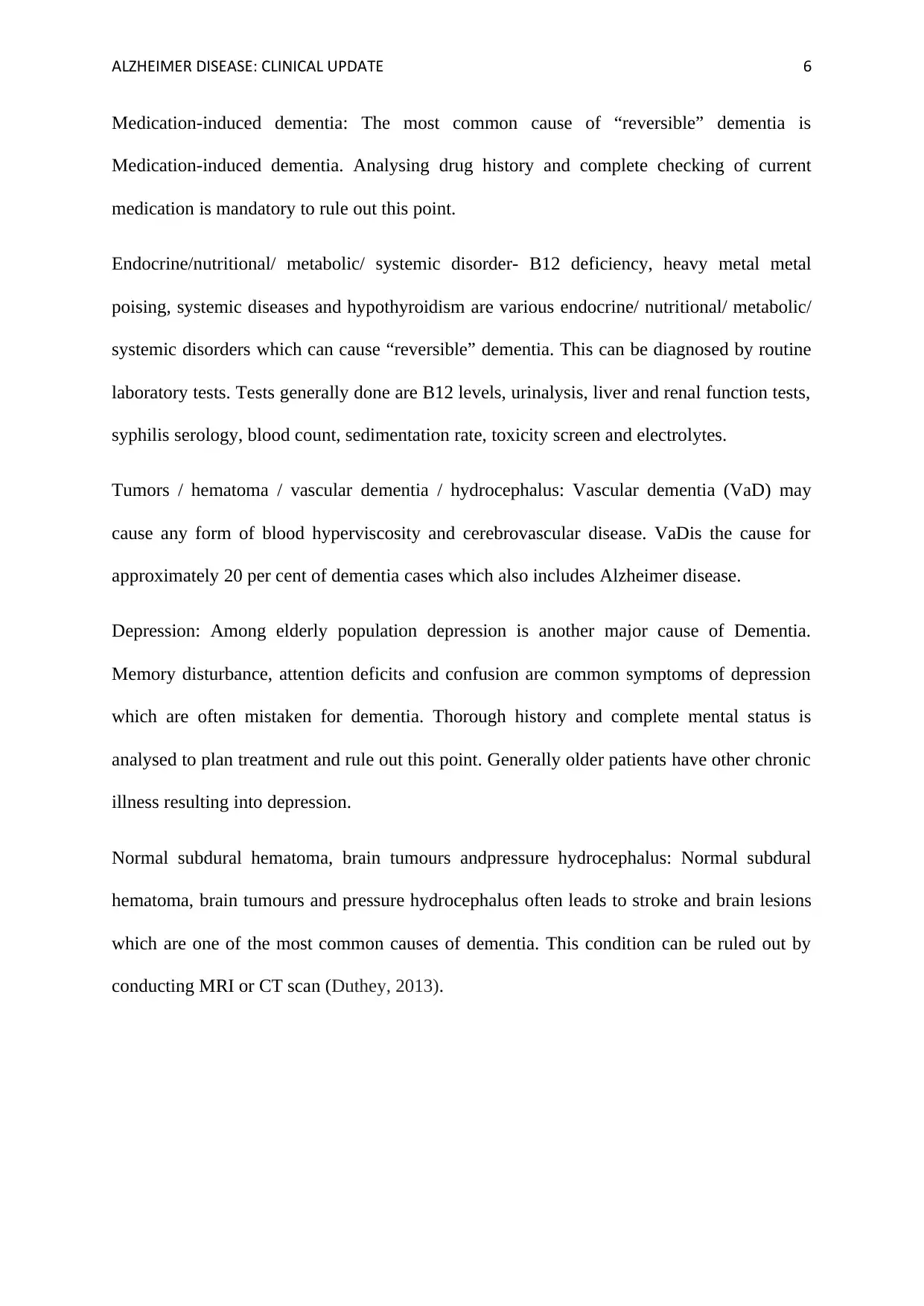
ALZHEIMER DISEASE: CLINICAL UPDATE 6
Medication-induced dementia: The most common cause of “reversible” dementia is
Medication-induced dementia. Analysing drug history and complete checking of current
medication is mandatory to rule out this point.
Endocrine/nutritional/ metabolic/ systemic disorder- B12 deficiency, heavy metal metal
poising, systemic diseases and hypothyroidism are various endocrine/ nutritional/ metabolic/
systemic disorders which can cause “reversible” dementia. This can be diagnosed by routine
laboratory tests. Tests generally done are B12 levels, urinalysis, liver and renal function tests,
syphilis serology, blood count, sedimentation rate, toxicity screen and electrolytes.
Tumors / hematoma / vascular dementia / hydrocephalus: Vascular dementia (VaD) may
cause any form of blood hyperviscosity and cerebrovascular disease. VaDis the cause for
approximately 20 per cent of dementia cases which also includes Alzheimer disease.
Depression: Among elderly population depression is another major cause of Dementia.
Memory disturbance, attention deficits and confusion are common symptoms of depression
which are often mistaken for dementia. Thorough history and complete mental status is
analysed to plan treatment and rule out this point. Generally older patients have other chronic
illness resulting into depression.
Normal subdural hematoma, brain tumours andpressure hydrocephalus: Normal subdural
hematoma, brain tumours and pressure hydrocephalus often leads to stroke and brain lesions
which are one of the most common causes of dementia. This condition can be ruled out by
conducting MRI or CT scan (Duthey, 2013).
Medication-induced dementia: The most common cause of “reversible” dementia is
Medication-induced dementia. Analysing drug history and complete checking of current
medication is mandatory to rule out this point.
Endocrine/nutritional/ metabolic/ systemic disorder- B12 deficiency, heavy metal metal
poising, systemic diseases and hypothyroidism are various endocrine/ nutritional/ metabolic/
systemic disorders which can cause “reversible” dementia. This can be diagnosed by routine
laboratory tests. Tests generally done are B12 levels, urinalysis, liver and renal function tests,
syphilis serology, blood count, sedimentation rate, toxicity screen and electrolytes.
Tumors / hematoma / vascular dementia / hydrocephalus: Vascular dementia (VaD) may
cause any form of blood hyperviscosity and cerebrovascular disease. VaDis the cause for
approximately 20 per cent of dementia cases which also includes Alzheimer disease.
Depression: Among elderly population depression is another major cause of Dementia.
Memory disturbance, attention deficits and confusion are common symptoms of depression
which are often mistaken for dementia. Thorough history and complete mental status is
analysed to plan treatment and rule out this point. Generally older patients have other chronic
illness resulting into depression.
Normal subdural hematoma, brain tumours andpressure hydrocephalus: Normal subdural
hematoma, brain tumours and pressure hydrocephalus often leads to stroke and brain lesions
which are one of the most common causes of dementia. This condition can be ruled out by
conducting MRI or CT scan (Duthey, 2013).
Paraphrase This Document
Need a fresh take? Get an instant paraphrase of this document with our AI Paraphraser

ALZHEIMER DISEASE: CLINICAL UPDATE 7
TREATMENT OPTIONS
Pharmacological management
Acetylcholinesterase inhibitors are widely used options for pharmacological intervention of
AD. According to a group reviewer of Quality Standard Sub committee of the American
Academy of Neurology, Acetylcholinesterase inhibitors should always be used as a first line
of treatment for mild to moderate Alzheimer’s disease. Functional, cognitive, and behavioural
symptoms of AD can be controlled using Acetylcholinesterase inhibitors. US Food and Drug
Administration has approved four Acetylcholinesterase inhibitor drugs- donepezil, tacrine,
galantamine and rivastigmine. Donepezil, galantamine and Tacrineselectively inhibit
acetylcholinesterase. Galantamine, rivastigmine and donepezil differ from each other in their
pharmacology and pharmacokinetics. All randomised, double-blind, parallel-group trials
were conducted for a short period which could not properly address the real time problems
(Salomone, Caraci, Leggio, Fedotova & Drago, 2012). The memantine an NMDA-receptor
partial antagonist- In the CNS, Glutamate is the prime neurotransmitter which plays major
role in neurotransmission and plasticity. NMDA is a glutamate receptor which generates
influx of Ca2+ into neurons. This influx results into long-term potentiation which is a cellular
process for memory and learning. In case of AD, increase in extracellular glutamate causes
excessive activation of NMDA receptors which results into excess accumulation of Ca2+.
This leads to death of neurons. Memantine is a moderate-affinity, non-competitive,
phencyclidine-site, NMDA antagonist which without preventing physiological activation of
the NMDA receptor protect neurons from glutamate-mediated excess accumulation of Ca2+.
Memantine was approved in Europe in Feb, 2002 for the treatment of moderately severe to
severe Alzheimer’s disease (Calhoun, King, Khoury &Grossberg, 2018).
TREATMENT OPTIONS
Pharmacological management
Acetylcholinesterase inhibitors are widely used options for pharmacological intervention of
AD. According to a group reviewer of Quality Standard Sub committee of the American
Academy of Neurology, Acetylcholinesterase inhibitors should always be used as a first line
of treatment for mild to moderate Alzheimer’s disease. Functional, cognitive, and behavioural
symptoms of AD can be controlled using Acetylcholinesterase inhibitors. US Food and Drug
Administration has approved four Acetylcholinesterase inhibitor drugs- donepezil, tacrine,
galantamine and rivastigmine. Donepezil, galantamine and Tacrineselectively inhibit
acetylcholinesterase. Galantamine, rivastigmine and donepezil differ from each other in their
pharmacology and pharmacokinetics. All randomised, double-blind, parallel-group trials
were conducted for a short period which could not properly address the real time problems
(Salomone, Caraci, Leggio, Fedotova & Drago, 2012). The memantine an NMDA-receptor
partial antagonist- In the CNS, Glutamate is the prime neurotransmitter which plays major
role in neurotransmission and plasticity. NMDA is a glutamate receptor which generates
influx of Ca2+ into neurons. This influx results into long-term potentiation which is a cellular
process for memory and learning. In case of AD, increase in extracellular glutamate causes
excessive activation of NMDA receptors which results into excess accumulation of Ca2+.
This leads to death of neurons. Memantine is a moderate-affinity, non-competitive,
phencyclidine-site, NMDA antagonist which without preventing physiological activation of
the NMDA receptor protect neurons from glutamate-mediated excess accumulation of Ca2+.
Memantine was approved in Europe in Feb, 2002 for the treatment of moderately severe to
severe Alzheimer’s disease (Calhoun, King, Khoury &Grossberg, 2018).
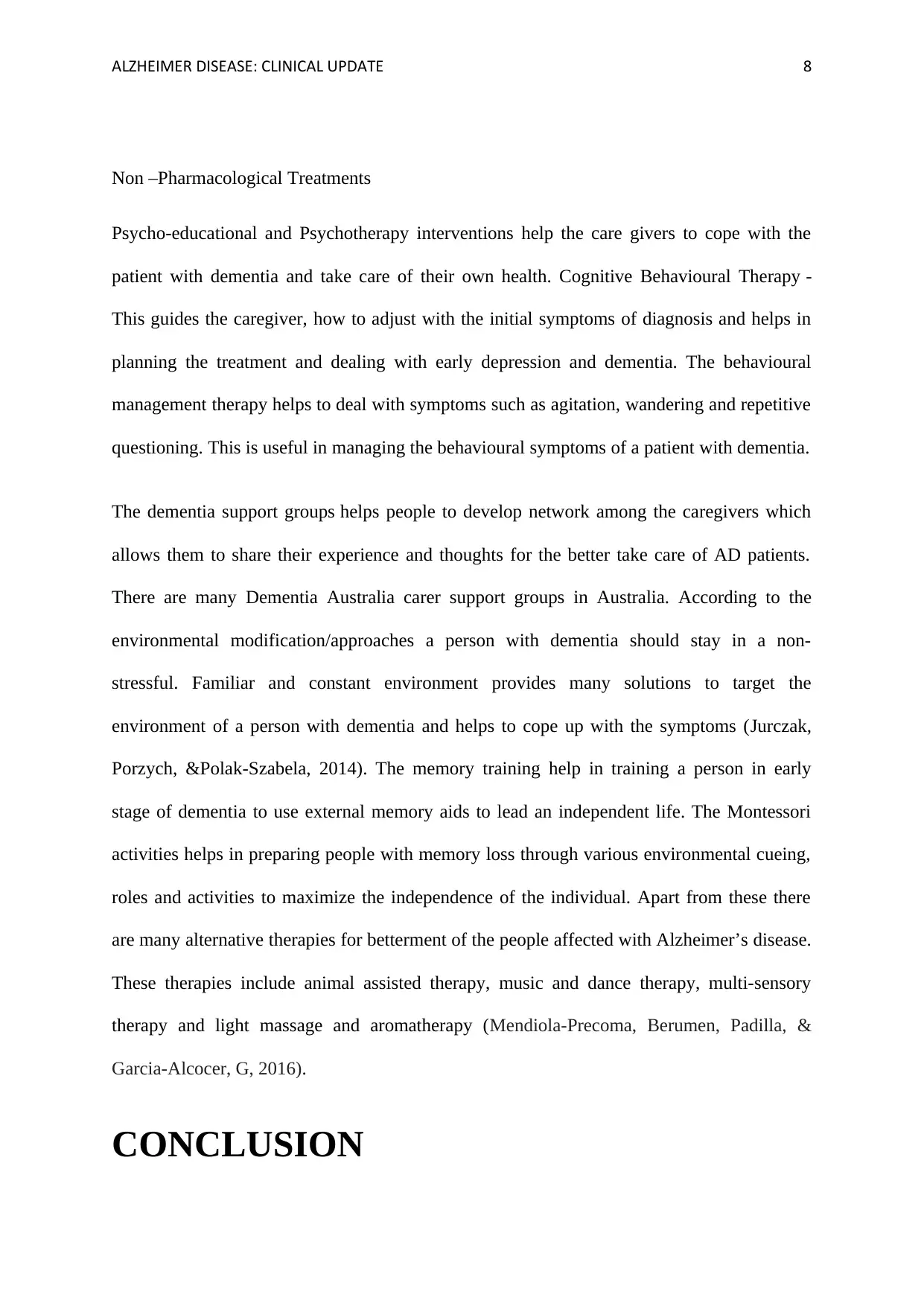
ALZHEIMER DISEASE: CLINICAL UPDATE 8
Non –Pharmacological Treatments
Psycho-educational and Psychotherapy interventions help the care givers to cope with the
patient with dementia and take care of their own health. Cognitive Behavioural Therapy -
This guides the caregiver, how to adjust with the initial symptoms of diagnosis and helps in
planning the treatment and dealing with early depression and dementia. The behavioural
management therapy helps to deal with symptoms such as agitation, wandering and repetitive
questioning. This is useful in managing the behavioural symptoms of a patient with dementia.
The dementia support groups helps people to develop network among the caregivers which
allows them to share their experience and thoughts for the better take care of AD patients.
There are many Dementia Australia carer support groups in Australia. According to the
environmental modification/approaches a person with dementia should stay in a non-
stressful. Familiar and constant environment provides many solutions to target the
environment of a person with dementia and helps to cope up with the symptoms (Jurczak,
Porzych, &Polak-Szabela, 2014). The memory training help in training a person in early
stage of dementia to use external memory aids to lead an independent life. The Montessori
activities helps in preparing people with memory loss through various environmental cueing,
roles and activities to maximize the independence of the individual. Apart from these there
are many alternative therapies for betterment of the people affected with Alzheimer’s disease.
These therapies include animal assisted therapy, music and dance therapy, multi-sensory
therapy and light massage and aromatherapy (Mendiola-Precoma, Berumen, Padilla, &
Garcia-Alcocer, G, 2016).
CONCLUSION
Non –Pharmacological Treatments
Psycho-educational and Psychotherapy interventions help the care givers to cope with the
patient with dementia and take care of their own health. Cognitive Behavioural Therapy -
This guides the caregiver, how to adjust with the initial symptoms of diagnosis and helps in
planning the treatment and dealing with early depression and dementia. The behavioural
management therapy helps to deal with symptoms such as agitation, wandering and repetitive
questioning. This is useful in managing the behavioural symptoms of a patient with dementia.
The dementia support groups helps people to develop network among the caregivers which
allows them to share their experience and thoughts for the better take care of AD patients.
There are many Dementia Australia carer support groups in Australia. According to the
environmental modification/approaches a person with dementia should stay in a non-
stressful. Familiar and constant environment provides many solutions to target the
environment of a person with dementia and helps to cope up with the symptoms (Jurczak,
Porzych, &Polak-Szabela, 2014). The memory training help in training a person in early
stage of dementia to use external memory aids to lead an independent life. The Montessori
activities helps in preparing people with memory loss through various environmental cueing,
roles and activities to maximize the independence of the individual. Apart from these there
are many alternative therapies for betterment of the people affected with Alzheimer’s disease.
These therapies include animal assisted therapy, music and dance therapy, multi-sensory
therapy and light massage and aromatherapy (Mendiola-Precoma, Berumen, Padilla, &
Garcia-Alcocer, G, 2016).
CONCLUSION
⊘ This is a preview!⊘
Do you want full access?
Subscribe today to unlock all pages.

Trusted by 1+ million students worldwide
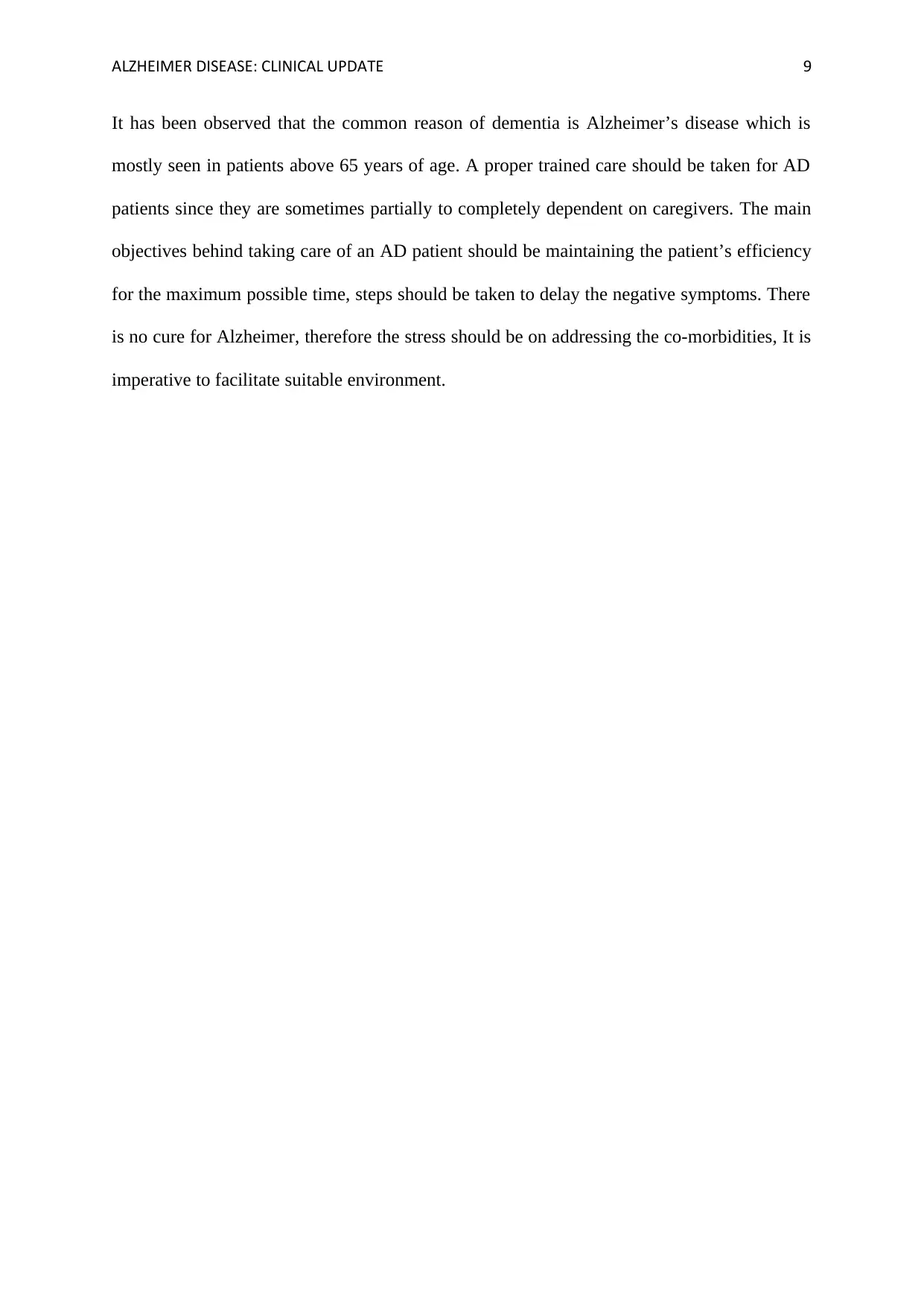
ALZHEIMER DISEASE: CLINICAL UPDATE 9
It has been observed that the common reason of dementia is Alzheimer’s disease which is
mostly seen in patients above 65 years of age. A proper trained care should be taken for AD
patients since they are sometimes partially to completely dependent on caregivers. The main
objectives behind taking care of an AD patient should be maintaining the patient’s efficiency
for the maximum possible time, steps should be taken to delay the negative symptoms. There
is no cure for Alzheimer, therefore the stress should be on addressing the co-morbidities, It is
imperative to facilitate suitable environment.
It has been observed that the common reason of dementia is Alzheimer’s disease which is
mostly seen in patients above 65 years of age. A proper trained care should be taken for AD
patients since they are sometimes partially to completely dependent on caregivers. The main
objectives behind taking care of an AD patient should be maintaining the patient’s efficiency
for the maximum possible time, steps should be taken to delay the negative symptoms. There
is no cure for Alzheimer, therefore the stress should be on addressing the co-morbidities, It is
imperative to facilitate suitable environment.
Paraphrase This Document
Need a fresh take? Get an instant paraphrase of this document with our AI Paraphraser
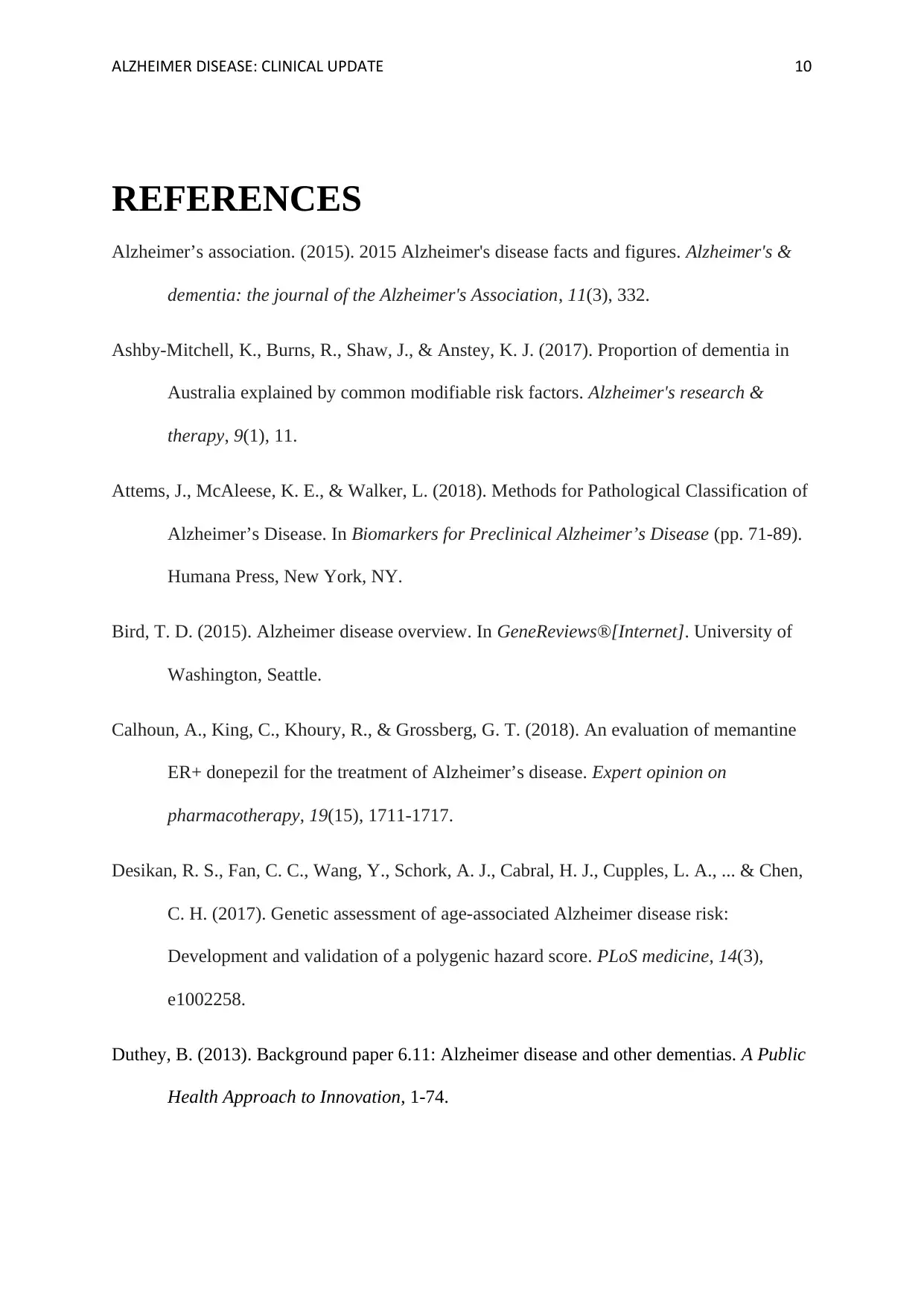
ALZHEIMER DISEASE: CLINICAL UPDATE 10
REFERENCES
Alzheimer’s association. (2015). 2015 Alzheimer's disease facts and figures. Alzheimer's &
dementia: the journal of the Alzheimer's Association, 11(3), 332.
Ashby-Mitchell, K., Burns, R., Shaw, J., & Anstey, K. J. (2017). Proportion of dementia in
Australia explained by common modifiable risk factors. Alzheimer's research &
therapy, 9(1), 11.
Attems, J., McAleese, K. E., & Walker, L. (2018). Methods for Pathological Classification of
Alzheimer’s Disease. In Biomarkers for Preclinical Alzheimer’s Disease (pp. 71-89).
Humana Press, New York, NY.
Bird, T. D. (2015). Alzheimer disease overview. In GeneReviews®[Internet]. University of
Washington, Seattle.
Calhoun, A., King, C., Khoury, R., & Grossberg, G. T. (2018). An evaluation of memantine
ER+ donepezil for the treatment of Alzheimer’s disease. Expert opinion on
pharmacotherapy, 19(15), 1711-1717.
Desikan, R. S., Fan, C. C., Wang, Y., Schork, A. J., Cabral, H. J., Cupples, L. A., ... & Chen,
C. H. (2017). Genetic assessment of age-associated Alzheimer disease risk:
Development and validation of a polygenic hazard score. PLoS medicine, 14(3),
e1002258.
Duthey, B. (2013). Background paper 6.11: Alzheimer disease and other dementias. A Public
Health Approach to Innovation, 1-74.
REFERENCES
Alzheimer’s association. (2015). 2015 Alzheimer's disease facts and figures. Alzheimer's &
dementia: the journal of the Alzheimer's Association, 11(3), 332.
Ashby-Mitchell, K., Burns, R., Shaw, J., & Anstey, K. J. (2017). Proportion of dementia in
Australia explained by common modifiable risk factors. Alzheimer's research &
therapy, 9(1), 11.
Attems, J., McAleese, K. E., & Walker, L. (2018). Methods for Pathological Classification of
Alzheimer’s Disease. In Biomarkers for Preclinical Alzheimer’s Disease (pp. 71-89).
Humana Press, New York, NY.
Bird, T. D. (2015). Alzheimer disease overview. In GeneReviews®[Internet]. University of
Washington, Seattle.
Calhoun, A., King, C., Khoury, R., & Grossberg, G. T. (2018). An evaluation of memantine
ER+ donepezil for the treatment of Alzheimer’s disease. Expert opinion on
pharmacotherapy, 19(15), 1711-1717.
Desikan, R. S., Fan, C. C., Wang, Y., Schork, A. J., Cabral, H. J., Cupples, L. A., ... & Chen,
C. H. (2017). Genetic assessment of age-associated Alzheimer disease risk:
Development and validation of a polygenic hazard score. PLoS medicine, 14(3),
e1002258.
Duthey, B. (2013). Background paper 6.11: Alzheimer disease and other dementias. A Public
Health Approach to Innovation, 1-74.
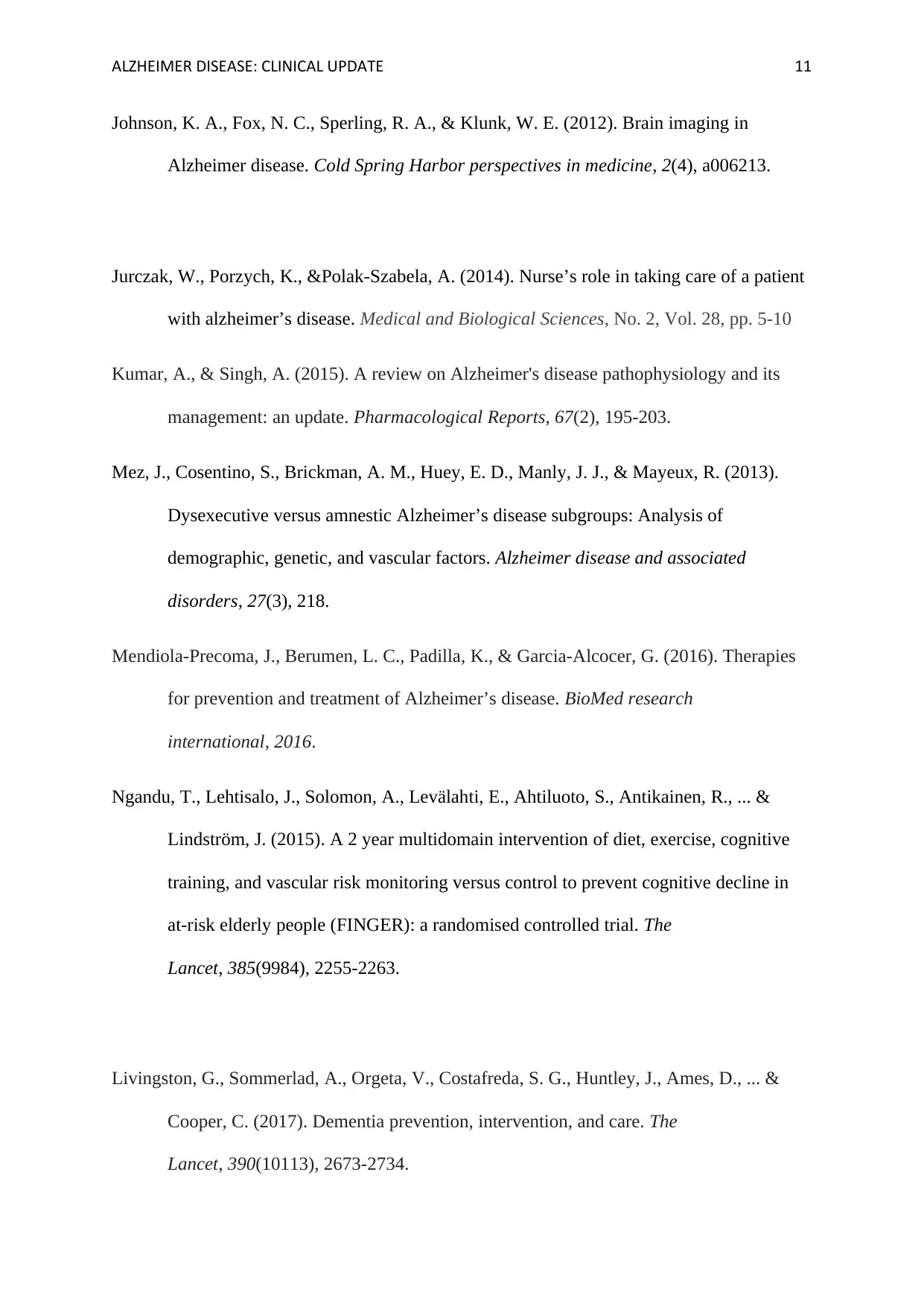
ALZHEIMER DISEASE: CLINICAL UPDATE 11
Johnson, K. A., Fox, N. C., Sperling, R. A., & Klunk, W. E. (2012). Brain imaging in
Alzheimer disease. Cold Spring Harbor perspectives in medicine, 2(4), a006213.
Jurczak, W., Porzych, K., &Polak-Szabela, A. (2014). Nurse’s role in taking care of a patient
with alzheimer’s disease. Medical and Biological Sciences, No. 2, Vol. 28, pp. 5-10
Kumar, A., & Singh, A. (2015). A review on Alzheimer's disease pathophysiology and its
management: an update. Pharmacological Reports, 67(2), 195-203.
Mez, J., Cosentino, S., Brickman, A. M., Huey, E. D., Manly, J. J., & Mayeux, R. (2013).
Dysexecutive versus amnestic Alzheimer’s disease subgroups: Analysis of
demographic, genetic, and vascular factors. Alzheimer disease and associated
disorders, 27(3), 218.
Mendiola-Precoma, J., Berumen, L. C., Padilla, K., & Garcia-Alcocer, G. (2016). Therapies
for prevention and treatment of Alzheimer’s disease. BioMed research
international, 2016.
Ngandu, T., Lehtisalo, J., Solomon, A., Levälahti, E., Ahtiluoto, S., Antikainen, R., ... &
Lindström, J. (2015). A 2 year multidomain intervention of diet, exercise, cognitive
training, and vascular risk monitoring versus control to prevent cognitive decline in
at-risk elderly people (FINGER): a randomised controlled trial. The
Lancet, 385(9984), 2255-2263.
Livingston, G., Sommerlad, A., Orgeta, V., Costafreda, S. G., Huntley, J., Ames, D., ... &
Cooper, C. (2017). Dementia prevention, intervention, and care. The
Lancet, 390(10113), 2673-2734.
Johnson, K. A., Fox, N. C., Sperling, R. A., & Klunk, W. E. (2012). Brain imaging in
Alzheimer disease. Cold Spring Harbor perspectives in medicine, 2(4), a006213.
Jurczak, W., Porzych, K., &Polak-Szabela, A. (2014). Nurse’s role in taking care of a patient
with alzheimer’s disease. Medical and Biological Sciences, No. 2, Vol. 28, pp. 5-10
Kumar, A., & Singh, A. (2015). A review on Alzheimer's disease pathophysiology and its
management: an update. Pharmacological Reports, 67(2), 195-203.
Mez, J., Cosentino, S., Brickman, A. M., Huey, E. D., Manly, J. J., & Mayeux, R. (2013).
Dysexecutive versus amnestic Alzheimer’s disease subgroups: Analysis of
demographic, genetic, and vascular factors. Alzheimer disease and associated
disorders, 27(3), 218.
Mendiola-Precoma, J., Berumen, L. C., Padilla, K., & Garcia-Alcocer, G. (2016). Therapies
for prevention and treatment of Alzheimer’s disease. BioMed research
international, 2016.
Ngandu, T., Lehtisalo, J., Solomon, A., Levälahti, E., Ahtiluoto, S., Antikainen, R., ... &
Lindström, J. (2015). A 2 year multidomain intervention of diet, exercise, cognitive
training, and vascular risk monitoring versus control to prevent cognitive decline in
at-risk elderly people (FINGER): a randomised controlled trial. The
Lancet, 385(9984), 2255-2263.
Livingston, G., Sommerlad, A., Orgeta, V., Costafreda, S. G., Huntley, J., Ames, D., ... &
Cooper, C. (2017). Dementia prevention, intervention, and care. The
Lancet, 390(10113), 2673-2734.
⊘ This is a preview!⊘
Do you want full access?
Subscribe today to unlock all pages.

Trusted by 1+ million students worldwide
1 out of 13
Related Documents
Your All-in-One AI-Powered Toolkit for Academic Success.
+13062052269
info@desklib.com
Available 24*7 on WhatsApp / Email
![[object Object]](/_next/static/media/star-bottom.7253800d.svg)
Unlock your academic potential
Copyright © 2020–2026 A2Z Services. All Rights Reserved. Developed and managed by ZUCOL.





